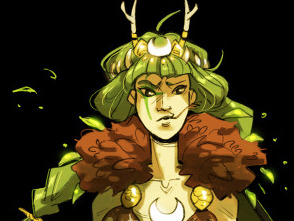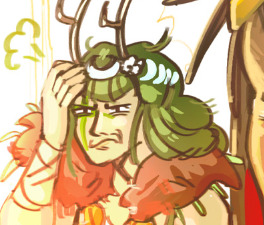#first pic is actually the only closest thing to hades artemis
Text
I find it funny that Hades game's style Artemis looks like this, with pretty neutral expression and soft face, baby girl baby

and i just decided
Nah






She is a gremlin (affectionate) <3
#first pic is actually the only closest thing to hades artemis#even here she is eeehhh less soft looking#bc she is always like this in my head#it was first art#then i went in full gremlin mode#mystuff
352 notes
·
View notes
Note
You rebloged a Hades/Persephone pic a while ago, and when I came across it in my dash, my first thought was that it was Anakin/Padme. And now I'm musing on who'd play the parts of Hades, Persephone, Eurydice, and Orpheus if that play was Star Wars? Who would you fit into those roles, do you think?
I haven’t seen Hadestown (which I assume you’re referencing when you say play), so I can’t really answer on that basis, but I am a big mythology buff so I’ll talk about that.
Before I can get to the Star Wars, though, I gotta talk about the mythology.
So, I basically have two distinct versions of the Hades and Persephone story in my head. Mythology is fluid and alive so I’m not about saying that there’s an “original” version of any myth, but it is true that the ancient and the modern interpretations of the story are very different.
Most modern retellings of the Persephone myth are a love story. And I’m not at all knocking this. I ship Hades/Persephone just like everyone else on tumblr. (I am, however, uncomfortable with the fact that so many modern retellings make Demeter either the antagonist or the outright villain, when the ancient Greeks pretty clearly saw her as a victim, but one who ultimately won against the systems stacked against her. Her takedown of Zeus is pretty damn epic, okay.)
By contrast, although the myth has always had the trappings of marriage and fertility rites, the ancient story was not really a love story. It wasn’t really a rape story, either, although that is the metaphor used (and we tend to be very uncomfortable with that fact now). It really can’t even be called the story of Hades and Persephone, as Hades is less a character or even a person, and more a force of nature. Because in the classical context this is really a story about death.
The version of the myth connected with Eleusis, so far as we can tell, is indeed a fertility myth, but it’s not actually very concerned with human fertility. It’s instead concerned with the life, death, and resurrection of seeds, and its concern with humans lies in the way that they resemble seeds.
Persephone is the seed goddess. Like the grain, she falls into the earth and dies, and with the coming of the growing season she is resurrected. Hades, who was not merely the god of death but also an earth god, is the ground that the seed goddess falls into, the ground in which she is buried only to rise again. And humans, who also are buried in the earth at death, could expect to emulate the dying and rising goddess of Eleusis if they were initiated into her mysteries.
So there’s a number of different stories here. There’s the love story, which is often painted in modern retellings as between the god of the underworld and the goddess of spring (even though in the ancient world there is no evidence that Persephone was ever regarded as a spring goddess, and all of the stories about her feature her in her role as awesome and terrible ruler of the underworld, a role in which Hades himself actually appears very infrequently). And because it’s seen as a love story between a happy, flowery, bright woman and a dark and brooding man, it tends to get read onto…pretty much every female hero / male villain (or anti-hero) pairing that exists. That’s not a reading I’m particularly fond of, but it’s definitely out there, and that’s the reading I see behind most of the Hades/Persephone comparisons to Anakin/Padme.
There are several other stories present in the myth of Persephone, Hades, and Demeter, though. There’s the story of the mother whose child has been stolen away, either by kidnapping (if taken literally) or by death (metaphorically). There’s the story of a woman going up against the entire patriarchal structure of her society to get her daughter back - and winning, but not without permanent consequences. There’s the story of a dying and rising goddess who comes into her full and awesome power, and then returns to offer humans the gifts of the mysteries she has discovered, mysteries beyond even the comprehension of the immortal gods.
So…all of that to get back to Star Wars. As I said, I don’t actually see a very strong fit for this myth with canon (though the closest canon parallel with a Greek underworld myth, I think, is actually Luke in ROTJ, who is a pretty clear Orpheus figure, though he goes to retrieve his father not his lover, and unlike Orpheus he is successful).
However, my AU Anabasis is more or less a take on the Hades and Persephone myth, with a few twists. (Even the name of the story, Anabasis, is a Greek word and means “coming up (from the underworld).”) It fits pretty well into the modern version of the myth, with Anakin as Hades and Padme as Persephone, and even does the enemies to friends to lovers thing.
But it also plays around with a few of the ancient takes on the story, and mixes up a few of the associations. Anakin, not Padme, is the child stolen by a figure representing death (Palpatine). And, for the entirety of the backstory, Shmi, who is pretty clearly the Demeter figure here, believes that her child is dead. But Padme is also something of a Demeter figure in the way that she goes up against Palpatine and his entire Imperial system in order to reclaim both the democracy she loves and the child Palpatine stole. And it’s Anakin who ate the metaphorical pomegranate: he is a Sith trained in the Dark Side, and nothing can ever make that not true. He can, however, ultimately choose what to do with that and how to claim it for himself, and in that way he’s the Persephone figure, claiming her full and terrible power and entirely remaking the underworld and the meaning of death itself.
Both Anakin and Padme metaphorically “die” in their final confrontation with Palpatine (and Anakin was actually literally dead for a very brief period during surgery, before Barriss revived him). They don’t start a mystery religion in the aftermath of their resurrection, but they are both very closely associated with secrets, with hidden knowledge and the toppling of old systems. The Persephone of the Eleusinian mysteries was sometimes described as a liberator, which is a strong element in both Anakin and Padme’s stories.
As for other characters: Shmi is a close fit for Demeter, and Kitster, I think, would be the Hermes character (he’s both a trickster figure and plays the role of psychopomp). Sabe, who has a strong association with both Padme and Anakin, might fit as Hecate. Palpatine plays both the Zeus and the Hades role, depending on how you’re interpreting the myth. Most of the Jedi characters, though, don’t really have Greek analogues, and I’m not sure the other agents do either (though maybe an argument could be made for Dinsa as the Artemis to Anakin’s Persephone).
#replies#lionheadbookends#my meta#this is honestly more mythology meta than star wars#there is one other thing anabasis anakin has in common with my headcanons about hades#(tho those headcanons have no supporting textual evidence in mythology)#they are both gardeners#greek mythology#persephone#demeter#hades#star wars#anabasis#padme amidala#anakin skywalker#shmi skywalker#warning for mentions of#death#rape
261 notes
·
View notes